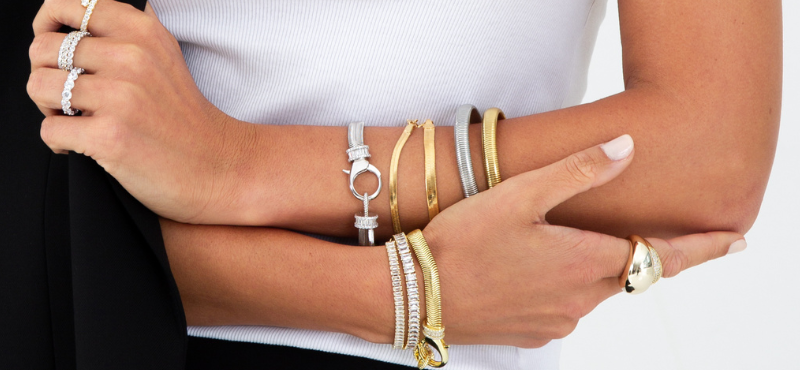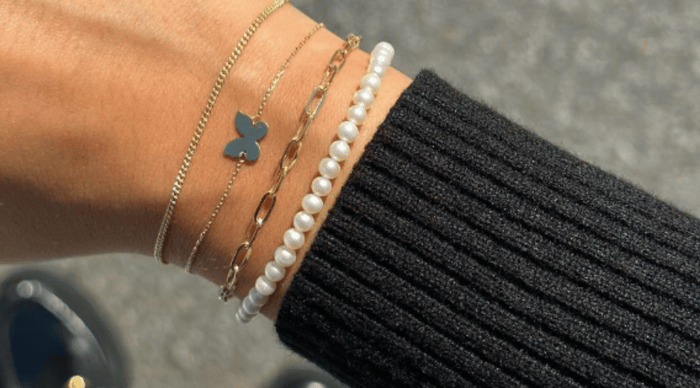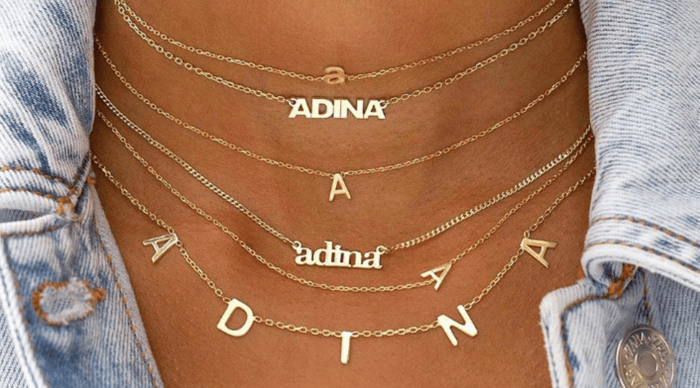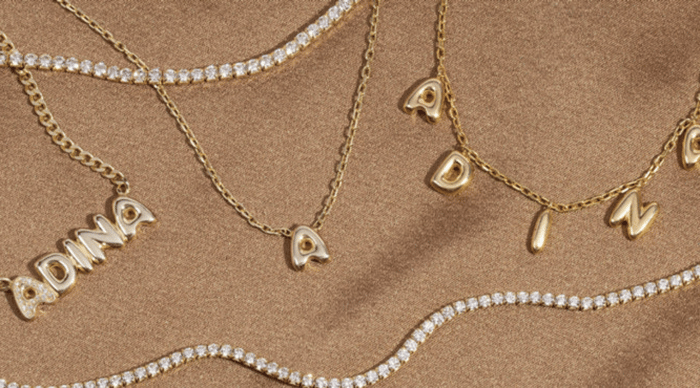When buying jewelry, your ultimate goal is two-fold: Find something you love that will last you for years to come! Do you want to find jewelry that's timeless and won't tarnish? There are certain high-quality jewelry materials that won’t tarnish as fast as others. No matter what kind of jewelry you end up buying, it’ll be up to you to take care of your jewelry to ensure it maintains its original quality over time.
Ahead, we'll explore why certain pieces retain their original luster and color over time, while other pieces may turn your finger green or start to show signs of wear. From gold and silver to titanium and tungsten, discover which materials don't require any extra maintenance or special storage solutions so you can enjoy your jewelry piece year after year. Read on for all the details about what jewelry doesn’t tarnish!
Overview of Jewelry Materials that Won't Tarnish
Most jewelry is formed with some kind of metal. Some of the most popular metals used in jewelry are gold, platinum, and silver.
When it comes to purchasing jewelry, we all want pieces that not only look stunning but are also durable and long-lasting. If you're tired of constantly cleaning your jewelry or seeing it tarnish over time, consider investing in pieces made from materials that won't tarnish, such as jasper stones.
This gemstone is known for its stunning array of colors and unique patterns, ranging from earthy browns to vibrant rustic reds. What sets jasper apart from other materials is its ability to resist tarnishing, so you can enjoy your jewelry for longer without the need for constant upkeep. Whether you prefer earrings, necklaces, or bracelets, jasper jewelry pieces typically have a pattern on them with a shiny exterior luster that can elevate any basic outfit.
However, what about basic jewelry that you can wear every day? Jasper is not typically seen as an everyday jewelry piece — but you’ll never tire of these metals ahead.
Why Does Jewelry Tarnish?
When jewelry is exposed to sweat, oils, air, and other factors, it can cause certain metals found in jewelry to tarnish over time.
Which Jewelry Metal Does Not Tarnish?

-
Pure gold
-
Platinum
-
Stainless Steel
When it comes to jewelry, one of the biggest frustrations can be finding pieces that won't tarnish after just a few wears. Luckily, there are several types of jewelry that are known for their ability to resist tarnishing. For example, one metal that's great for tarnish-free jewelry is stainless steel. This strong and durable material is perfect for those who want to wear their jewelry every day without worrying about it losing its shine.
Below, learn more about the most popular metals for jewelry that don’t tarnish.
a. Gold

Gold has captured the hearts and imaginations of people for centuries. This precious metal has been coveted by many for its beauty, rarity, and enduring value. From ancient civilizations to modern times, gold has been used as currency, jewelry, and an investment. Its natural luster and shine are unparalleled, and its color range from pale yellow to deep red makes it a versatile and timeless material. Whether you're admiring gold jewelry or investing in gold bullion, there's no denying the allure and fascination that this shiny metal holds.
Pure gold doesn’t tarnish. However gold is often mixed with other metals to create jewelry so that it’s more durable. Even though solid gold jewelry isn’t completely tarnish proof, it’s pricier than other golds and lasts a longer time in good condition as long as you take good care of it.
Gold plated jewelry, on the other hand, typically tarnishes after a short period of time because the gold is thin and will show the base material as it fades. Gold vermeil is an affordable type of gold jewelry for those with allergic reactions to jewelry. Even though it’s plated with gold, the layer of gold is thicher than gold plated jewelry, and thus lasts longer. Gold filled, not to be confused with gold plated, has a base metal of copper, brass, and other materials just like gold plated jewelry. Unlike gold plated jewelry, gold filled jewelry has a thicker layer of solid gold, which allows the jewelry to last longer without tarnishing.
Overall, the best type of gold jewelry is solid gold jewelry because it’s higher quality and lasts longer without tarnishing!
b. Platinum
Platinum is a rare and highly valued precious metal that has been sought after for centuries. With its lustrous white-silver color and impressive durability, platinum has become a symbol of power and luxury.
Throughout history, it has been used to create coins, jewelry, and even scientific equipment due to its resistance to corrosion and high melting point. Today, platinum is still a highly coveted commodity, and its value often exceeds that of gold. From engagement rings to commemorative coins, platinum has established itself as an enduring symbol of wealth and status with any piece of jewelry
Platnium is a type of white metal, like silver jewelry. It’s so lusterous, that it doesn’t need rhodium plating to give it that white shiny look. It’s also a great metal for those who are reactive and sensitive to other types of metals. Most platinum is made from the mineral called platinum sulfide. Platinum jewelry can last you a lifetime with its lack of reactive properties that allow it to shine and luster without rusting or tarnishing!
c. Stainless Steel
Stainless steel is a popular material used in various industries, from construction to healthcare. Its durability, corrosion resistance, and sleek appearance make it a go-to choice for many applications.
The unique blend of metals that make up stainless steel, primarily iron, chromium, and nickel, gives it its characteristic attributes. It is also known for being environmentally friendly, as it is fully recyclable and has a long lifespan. Whether it's in the form of a kitchen appliance or a piece of jewelry, stainless steel's versatility and strength make it a reliable choice for any project.
You’ll be happy to see that your stainless steel jewelry doesn’t rust or change color over time, thanks its layer of chromium, which is resistant to tarnishing. Stainless steel will last you longer than sterling silver jewelry (composed of pure silver and other metals), which doesn’t contain the same corrosion properties.
How to Prevent Jewelry From Tarnishing
Jewelry is not only about enhancing your looks but also about making a statement. It's like a prized possession that you want to keep looking new and shiny for years to come. But, jewelry tarnishing and losing its luster is something that often frustrates its owners.
However, the good news is that with a little care, you can prevent this from happening. One of the easiest ways to prevent tarnishing is by storing your jewelry properly. Avoid exposing it to moist or humid environments and always ensure that the pieces are dry before storing them. Additionally, you can also use anti-tarnish strips or pouches to keep your jewelry in its best condition. With these simple jewelry care tips, your jewelry will look as good as new!
-
Keep your jewelry in a jewelry box or dry place to prevent moisture and sun from touching it
-
Don’t wear jewelry while exercising or doing anything that will cause jewelry to come in contact with sweat
-
Separate your jewelry by metals and type (fine jewelry should be separate from costume jewelry)
Benefits of Choosing Non-Tarnishing Jewelry
Why Should You Invest in Non-Tarnishing Jewelry?
Non-tarnishing jewelry brings a myriad of benefits. Firstly, it retains its shine and luster, making it an investment that lasts. Unlike traditional jewelry, which requires constant polishing to maintain its brilliance, non-tarnishing jewelry is easy to care for and requires little maintenance. This means that you can wear your favorite pieces every day without worrying about fading or discoloration. Additionally, non-tarnishing jewelry is often hypoallergenic, making it perfect for those with sensitive skin or allergic reactions to certain metals.
In conclusion, deciding between different types of jewelry that won't tarnish can be an important factor when shopping for jewelry pieces. With solid gold, platinum, and stainless steel being the most popular metals to choose from that are not prone to tarnishing, there is something for everyone.
When selecting any type of jewelry from whatever metal it is made from, taking proper care of your pieces should also be taken into account when considering how long it will last over time. Non-tarnishing pieces are much easier to take care of and require less maintenance than other options. Ultimately, choosing non-tarnishing jewelry can make a big difference in the longevity and appearance of your pieces while giving you peace of mind knowing they will stay looking beautiful for years to come.















